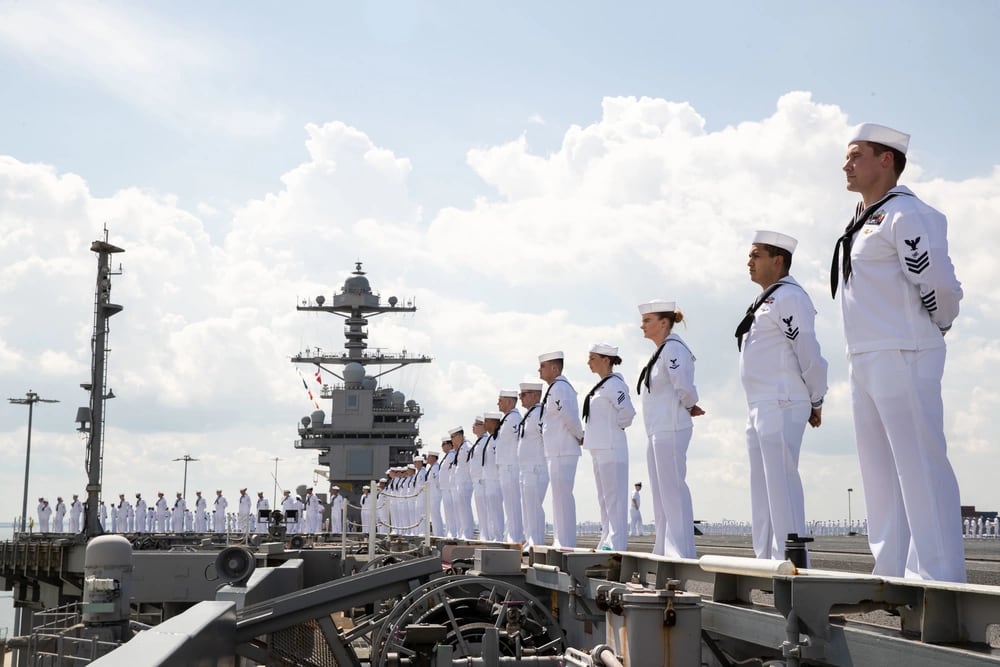Big Navy is pledging to do better when it comes to systemic shortfalls impacting sailor pay, including Basic Allowance for Housing, special pay entitlements and permanent change of station travel pay, as well as separation and retirement processing.
In a task order announced Thursday by the commanders of U.S. Fleet Forces Command, U.S. Pacific Fleet and Naval Forces Europe-Africa, leadership pledged to “quickly improve the timeliness and accuracy of Sailors’ pay.”
“Our Sailors and their families must be paid accurately, consistently, reliably and, most importantly, on time,” the task order states. “This is both a quality of life and a readiness issue, and it is certainly Commanders’ business.”
Most significantly for the men and women out in the fleet, by Dec. 31 “all Sailors will receive pay and entitlements within 14 days of becoming eligible for the pay or entitlement.”
You can read the task order at the link below.
RELATED
Coordinated Task Order
“Good, bad or ugly, it is important that we get after issues that are impeding readiness and our ability to be the best Navy in the world,” said Adm. Daryl Caudle, the commander of U.S. Fleet Forces Command, in a statement. “Input from our fleet Sailors made it very clear that our pay system is not running smoothly, which is impacting Sailor and family readiness. Timely and accurate pay for our Sailors is a no-fail mission and the task order is our initial plan to get after it.”
These issues stem from a lack of standard processes, inadequate training for pay administrators and “immature information technology” coupled with an over-centralization of transaction service and regional support centers, the commander of MyNavy Career Center, Rear Adm. Stu Satterwhite, said in a statement.
All these issues were aggravated by “a surge of high-priority transactions” supporting families in the wake of the Red Hill fuel spill in Hawaii, leading to “a large number of pay transactions” that need to be drawn down.
Officials did not respond to Navy Times’ follow-up questions regarding the precise number of sailors affected by deadline, but the broad and high-profile nature of Thursday’s task order suggests these are not isolated incidents.
“Bottom line, the amount of work in waiting is completely unacceptable, and we are working toward quickly drawing it down and getting our Sailor Pay program back on track,” Satterwhite said in the statement. “We are in the process of transitioning to a more modern program that manages timely and accurate pay for our Sailors.”
In addition to pay issues, the task order states that other lines of effort regarding sailor services during maintenance availabilities and unaccompanied housing will also be addressed “in the coming weeks.”
“We expect every supporting Commander to aggressively correct problems within his or her area of responsibility and complete assigned tasks with a sense of urgency and enthusiastic passion,” the order states. “If a barrier is discovered that is beyond your ability to resolve, rapidly elevate it.”
RELATED

The admirals plan to work with the chief of naval personnel in the near term to get rid of a backlog of overdue PCS and separation and retirement claims, ensuring sailors have their DD-214s in hand before they leave the service, no later than Dec. 15.
In addition, they plan to make sure no claims older than 30 days are in the queue by that date.
The Navy also plans to transition its MyNavy Career Center enterprise to a new Human Resources Information System by the end of 2022, which will aim to provide “timely and accurate Sailor Pay and entitlements within 14 days of that initial documented submission without the need to resubmit.”
The Navy is also bringing sailors in for training at centers where claims are processed.
After the training, these “waterfront tiger teams” will head back to their commands to serve as a point person for such transactions.
Those teams will start coming into place by the end of the month, according to the Navy.
The effort will also include returning pay and personnel administration and release authority to the commands by Oct. 30.
Navy Times has reported on these issues repeatedly in the past year, but Chief of Naval Personnel public affairs officers have regularly framed the widespread problems as temporary blips on the way to a more modern and efficient pay and personnel network.
RELATED

In August, CNP spokesman Capt. Dave Hecht told Navy Times that “unanticipated errors” last summer occurred as Big Navy transitioned its personnel systems, leaving some sailors unpaid, without ID cards and unable to access Tricare benefits.
Hecht said then that most of the issues had been resolved, but that the problems stemmed from the Navy consolidating its Navy Enlisted System and Officer Personnel Information System into a streamlined Navy Standard Integrated Personnel System, or NSIPS.
“Unfortunately, there were errors and issues which impacted Sailors,” he said. “As errors were identified, they have been aggressively worked.”

Back then, Hecht said any remaining pay issues were expected to be resolved by Sept. 1.
“The complexities of these very old legacy systems were known, and challenges were anticipated,” Hecht said. “Issues impacting pay receive the highest priority to ensure that every Sailor receives everything to which they are entitled, and actions were taken within 24 hours of issue identification to resolve the issues.”
But pay issues have stubbornly persisted, as have delays in sailors receiving their DD-214 paperwork upon leaving the service.
Understandably frustrated sailors and spouses have regularly taken to trolling the MyNavy HR Facebook page for what they perceive as a lack of answers or clarity regarding the timeline for fixing such critical problems.
In a video posted to the page last month, Fleet Master Chief for Manpower, Personnel, Training and Education Delbert Terrell gave a nod to the trolling and said the comments “cut right to the bone.”
“You’re absolutely right to be critical of our performance,” Terrell said. “It’s your pay, it’s your benefits, it’s your career. … When we don’t hit the mark, it has a direct impact on you, your shipmates and your families.”
RELATED
One recently retired sailor told Navy Times in September that he got his first retired paycheck Sept. 11, nearly six weeks after it was supposed to start on Aug. 1. While he said he was fine financially before the retired pay kicked in, he is concerned about others.
“I remain concerned about their process,” he said. “Why not put effort into communicating problems rather than staying quiet? … I could really see this having an effect on people. … This could be crippling for someone with dependents and limited emergency savings.”
One officer who had her pay affected by the system outage last summer wondered why Big Navy wasn’t better prepared for these challenges.
“I feel privileged that my spouse can pay our bills, but I know there are people who probably aren’t so fortunate to have someone else that they can rely on,” the officer told Navy Times.
The officer, who noted the local personnel support office reported being flooded with “a lot of angry calls” about the system outage, questioned whether everyone was in the loop about the transition and its issues.
“The most disappointing part is that the people who are tasked with bringing people into the Navy and doing what we think is important work, to take care of our sailors, they weren’t prepared to do their jobs,” the officer added. “Instead, ‘Joe Shmoe’ is fielding tons of angry phone calls from people like me. They’re trying to do their jobs, and the Navy didn’t prepare to do that.”
Under the task order, every command will be ordered to submit weekly pay transaction reports that will include “the number of transactions in the queue, the oldest pay transaction, the number of transactions returned that week, and the average days to process entitlements from initiation to payment,” according to the task order.
Commanders will also have to report any outstanding pay claims that have not been processed or submitted to the career center within two weeks, including corrective actions and causes.
Each fleet’s manpower and personnel department, or N1, will also be responsible for tracking trends, providing training and overseeing command visits, among other duties.
Geoff is the managing editor of Military Times, but he still loves writing stories. He covered Iraq and Afghanistan extensively and was a reporter at the Chicago Tribune. He welcomes any and all kinds of tips at geoffz@militarytimes.com.





